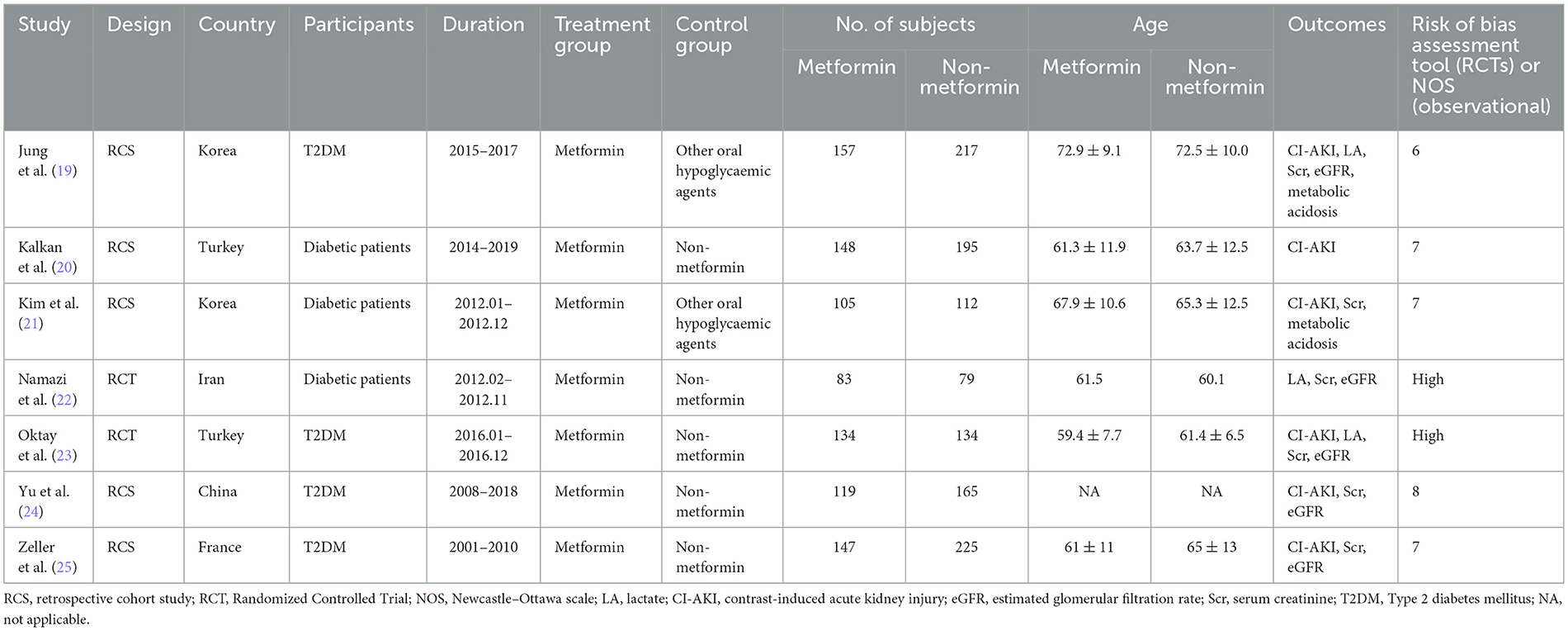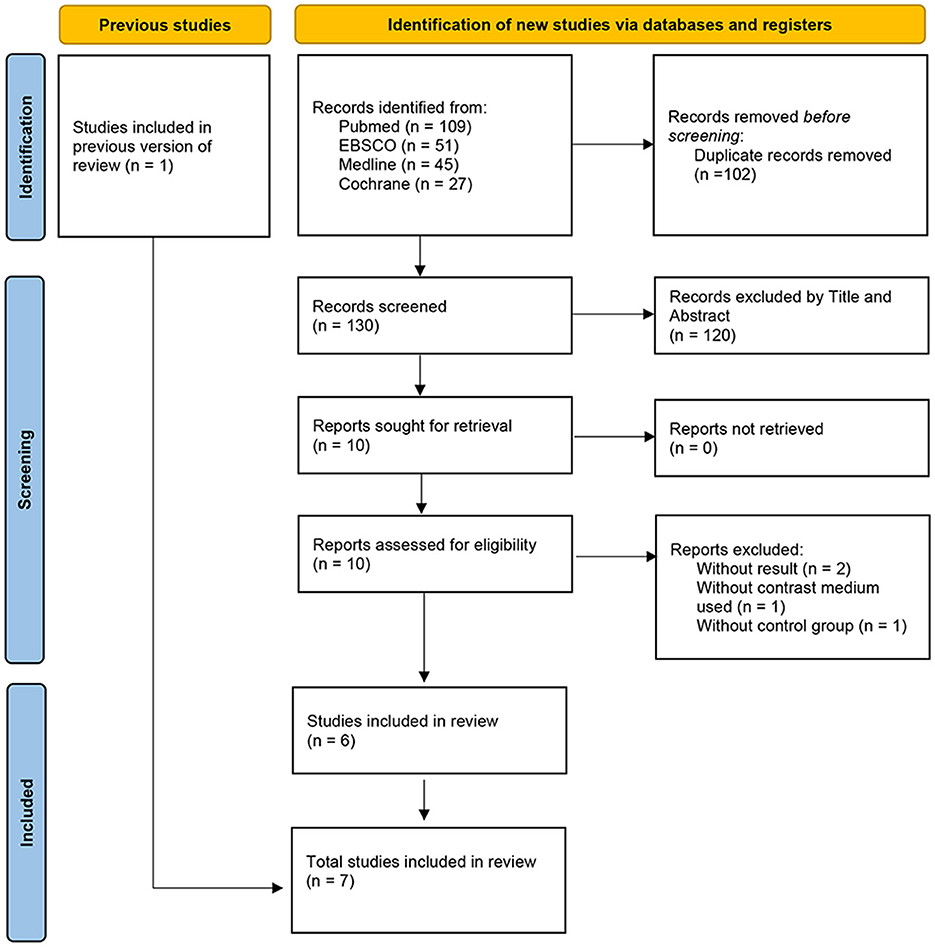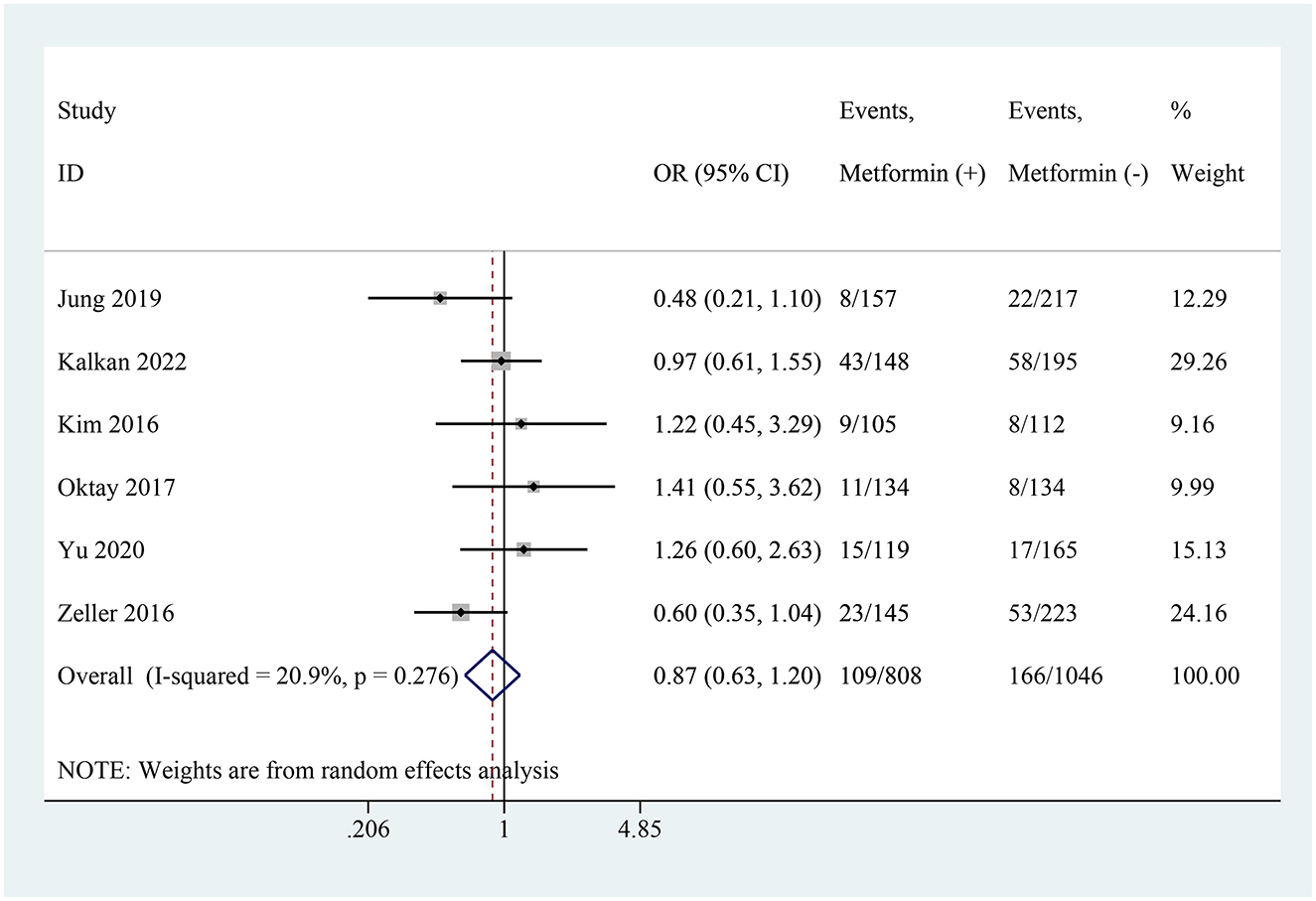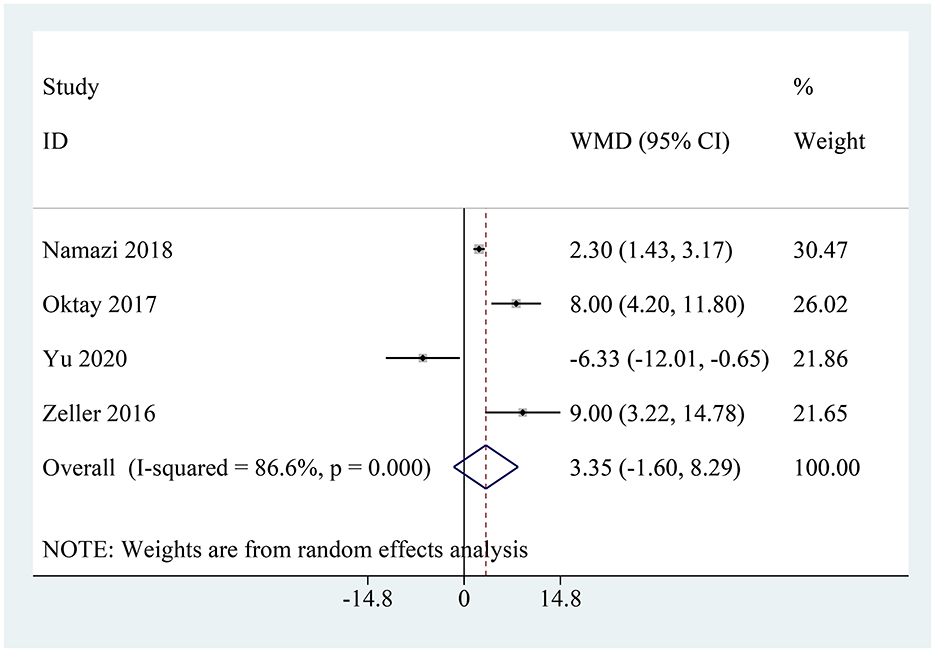- 1Department of Radiology, Taizhou Hospital of Zhejiang Province Affiliated to Wenzhou Medical University, Taizhou, Zhejiang, China
- 2General Surgical Department, Taizhou Hospital of Zhejiang Province, Zhejiang University, Taizhou, Zhejiang, China
- 3Department of Nursing, Zhejiang University School of Medicine First Affiliated Hospital, Hangzhou, Zhejiang, China
- 4Department of Orthopedics, Taizhou Hospital of Zhejiang Province Affiliated to Wenzhou Medical University, Taizhou, Zhejiang, China
Purpose: Our study aimed to determine through a meta-analysis whether continuing metformin use in diabetic patients receiving contrast agents would increase the risk of renal impairment and metabolic abnormalities.
Methods: We searched the PubMed, EBSCO, Medline, and the Cochrane Central Register of Controlled Trials from the inception dates to March 2024. The included studies comparing metformin users and non-users during contrast agent administration in diabetic patients. Outcome measures included contrast-induced acute kidney injury (CI-AKI), serum creatinine, estimated glomerular filtration rate (eGFR), lactate level, and incidence of metabolic acidosis. We used odds ratio (OR) for dichotomous outcomes and weighted or standardized mean difference (WMD or SMD) for continuous outcomes, depending on scale consistency across studies.
Results: Analysis involved 2 randomized controlled trials and 5 retrospective cohorts comprising 2020 patients. There were no significant differences between the metformin and non-metformin groups in CI-AKI incidence (OR: 0.87, 95% CI: 0.63–1.20), changes in renal function (serum creatinine: SMD: −0.15, 95% CI: −0.64–0.35; eGFR: WMD: 3.35, 95% CI: −1.60–8.29), incidence of metabolic acidosis (OR: 0.90, 95% CI: 0.57–1.43), and lactate levels (SMD: 0.29, 95% CI: −0.53–1.11). Sensitivity analysis excluding one study revealed a significant reduction in creatinine with metformin. Logistic regression meta-analysis showed that metformin use was not significantly associated with CI-AKI or metabolic acidosis, while contrast volume was the only consistent predictor of CI-AKI. Lower baseline CO2 was independently associated with increased risk of metabolic acidosis.
Conclusions: Our analysis indicates that continuing metformin during contrast agent administration does not increase the risk of CI-AKI, acidosis, or eGFR compared to discontinuation or non-use of metformin. Additionally, continuation of metformin may be associated with a modest reduction in serum creatinine levels after contrast exposure. However, the limited quality of included studies may weaken the strength of these conclusions.
Systematic review registration: https://www.crd.york.ac.uk/PROSPERO/view/CRD42023459602, identifier: CRD42023459602.
Introduction
Type 2 diabetes mellitus (T2DM) represents one of the most significant health challenges of the twenty-first century, with a global prevalence on the rise. Data from the IDF Global Diabetes Map indicates that in 2025, the global adult diabetes population reached 589 million (11.1%) (1). T2DM can directly or indirectly lead to other more severe conditions, with ~30–40% of diabetic patients progressing to chronic kidney disease (2). Diabetic kidney disease stands as one of the leading causes of mortality among T2DM patients and is a primary contributor to end-stage renal disease worldwide, posing immense risks (3). Metformin serves as a frontline therapeutic agent for T2DM. In patients with preserved renal function, metformin does not exert direct nephrotoxic effects; however, in the presence of renal impairment, metformin can elevate blood lactate levels by inhibiting lactate metabolism, thereby resulting in metformin-associated lactic acidosis, with mortality rates reaching 30–50% (4). Additionally, patients seemingly with normal renal function but at risk of acute kidney injury (AKI), such as those with volume depletion, heart failure, sepsis, or exposure to nephrotoxic agents, also face an increased likelihood of developing metformin-associated lactic acidosis. Metformin increases lactate concentration primarily through its inhibitory effect on mitochondrial respiratory chain complex I, leading to reduced oxidative phosphorylation and a shift toward anaerobic glycolysis, thereby promoting lactate production (5). Additionally, metformin suppresses hepatic gluconeogenesis, particularly through inhibition of mitochondrial glycerophosphate dehydrogenase, leading to decreased hepatic lactate uptake and clearance (6). These effects are generally well-tolerated in patients with normal renal and hepatic function. However, in individuals with impaired renal function or tissue hypoxia, the reduced clearance and increased production of lactate can synergistically increase the risk of metformin-associated lactic acidosis (7). With the widespread use of contrast media (CM) in diagnostic and interventional procedures, contrast-induced acute kidney injury (CI-AKI) is becoming increasingly prevalent. While CI-AKI incidence ranges from 12 to 27% in the general population, the rate increases to 50% or more in patients with multiple risk factors (8). Consequently, early expert consensus and guidelines strongly recommend discontinuing metformin prior to CM use in T2DM patients (9, 10). However, emerging research suggests that the role of metformin in lactic acidosis may be overemphasized, with most complications related to T2DM serving as the primary culprits (11–13). In recent years, several guidelines regarding metformin have been revised. For instance, the American College of Radiology (ACR) revised its 2015 version recommendations for patients with an estimated glomerular filtration rate (eGFR) of 30–60 mL/min/1.73 m2. Previous versions advised discontinuation within 48 h post-surgery, while the new version (2023 edition) suggests continuation without cessation (9, 10, 14). While these updates are promising, they lack a strong evidence base, often relying on limited or outdated studies. This gap highlights the need for a comprehensive and up-to-date evaluation of the available evidence. Therefore, we conducted this study to rigorously assess whether discontinuing metformin prior to imaging in diabetic patients provides direct evidence on how to manage metformin use for T2DM patients undergoing CM administration. Our study aims to fill the gaps in the existing guidelines and provide more definitive evidence to guide clinical practice.
Methods
The study conforms to the principles outlined in the Handbook of the Cochrane Collaboration (15), along with the guidelines established by the PRISMA statement (16). The protocol for this meta-analysis was registered on PROSPERO (Registration No: CRD 42023459602).
Inclusion criteria
(1) Study compared patients with diabetes who were using metformin vs. those who were not using metformin during the administration of contrast agents;
(2) Study focused on relevant outcome;
(3) Diabetic patients (including T1DM & T2DM).
Exclusion criteria
(1) Studies if they were letters, case reports, reviews, animal trials, or republished studies;
(2) Articles with missing data;
(3) Non-diabetic patient;
(4) Immunological diseases.
Outcomes
The primary outcome was CI-AKI after the recent contrast medium injection. Secondary outcomes were serum creatinine, eGFR, lactate level, and incidence of metabolic acidosis after contrast medium used.
Search strategy
Two of the authors performed the search in PubMed, EBSCO, Medline, and the Cochrane Central Register of Controlled Trials from the inception dates to March 2024, using the keywords “metformin” and “contrast medium” and “diabetes” and “(renal function OR serum creatinine OR eGFR OR lactate level OR metabolic acidosis)”.
Data collection process
Two investigators used a standard data extraction form to extract all related data from selected studies independently. Data extracted included the first author's name, year of publication, country, type of study, sample size, age, and outcomes. Disagreements were resolved by consensus.
Assessment of risk of bias and quality of evidence
Two researchers independently assessed the quality of all included studies based on Cochrane risk-of-bias criteria or the Newcastle–Ottawa scale (NOS) (17, 18).
Data synthesis
The meta-analysis used Stata (version 17). Heterogeneity was assessed by the Q-test and I2-value. A random effects model was applied. Odds ratios (OR) with 95% CI were used for dichotomous outcomes. For continuous outcomes, weighted mean differences (WMDs) were used when measurement scales were consistent across studies, and standardized mean differences (SMDs) were applied when different scales were used. Statistical significance was set at P < 0.05.
Results
A total of 232 potentially relevant articles were retrieved. After excluding 102 duplicate articles, a review of titles and abstracts of the remaining 130 articles led to the exclusion of 120 articles. Upon full-text reading of the remaining 10 articles, 4 articles were further excluded (2 clinical trials with no results, 1 article not using CM, and 1 article lacking a control group). Additionally, 1 previously conducted systematic review article was included, resulting in a total of 7 studies meeting our eligibility criteria (19–25). These studies comprised 2020 diabetic patients, among whom 893 continued metformin use during CM examinations, while 1,127 did not. The included 7 studies consisted of 2 RCTs and 5 retrospective cohort studies, with basic information about the included studies detailed in Table 1. Results indicated generally high quality across the included studies. The study flow diagram is depicted in Figure 1.
CI-AKI
In the 7 studies, 6 studies described the incidence rate of CI-AKI (19–21, 23–25). Their results consistently found that the risk of developing CI-AKI after CM administration was not associated with the use of metformin. The pooled analysis showed that there was no statistically significant increase in the risk of CI-AKI among patients continuing metformin use (OR: 0.87, 95% CI: 0.63–1.20, I2 = 20.9%, P = 0.404; Figure 2).
Serum creatinine
A total of 5 studies reported serum creatinine levels (19, 22–25) among which 3 studies found that patients continuing metformin use showed decrease serum creatinine levels compared to the non-metformin group after receiving CM (19, 22, 25), while 1 studies found no difference between the two groups (23). In contrast, one study reported that continuing metformin was associated with increased serum creatinine levels (24). The pooled analysis indicated that there was no difference in creatinine levels between diabetic patients continuing metformin use and those not using metformin after CM (SMD: −0.15, 95% CI: −0.64–0.35, I2 = 95.3%, P = 0.562; Figure 3A). However, when the study by Yu et al. (24) was excluded in sensitivity analysis due to its methodological heterogeneity and large contribution to between-study variance, the results changed notably. The updated pooled analysis based on the remaining four studies showed a statistically significant reduction in serum creatinine levels in the metformin group (SMD: −0.38, 95% CI: −0.58 to −0.18; I2 = 63.5%, P < 0.001; Figure 3B).
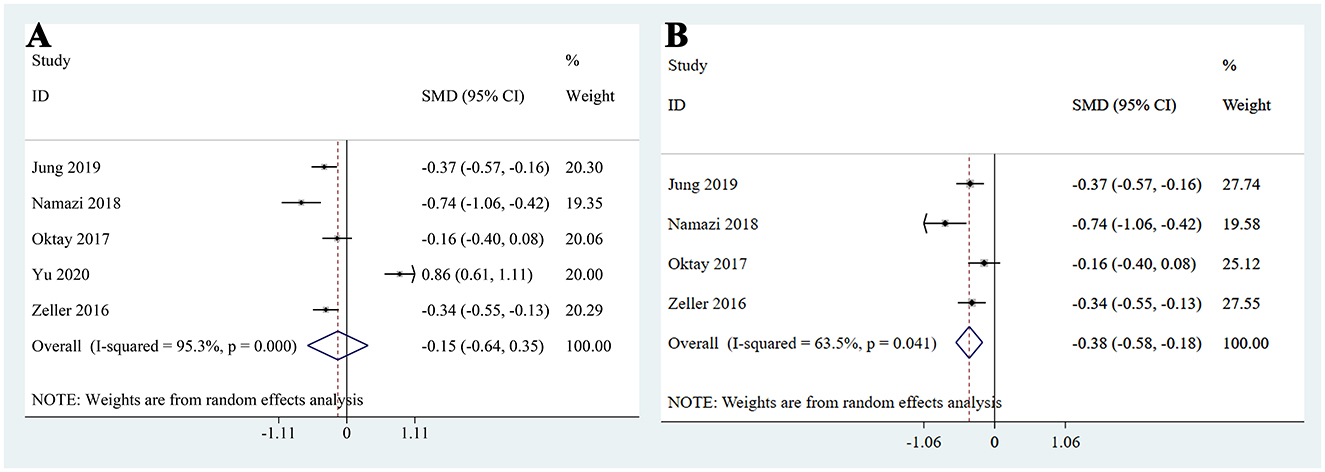
Figure 3. Pooled analysis of serum creatinine between the metformin and non-metformin (A) Overall pooled analysis; (B) Sensitivity analysis excluding the study by Yu et al. due to high heterogeneity.
eGFR
Four studies reported on the eGFR situation (22–25). Among them, three studies found that the eGFR values in the metformin group were higher than those in the control group. However, Zeller et al.'s (25) study found that the eGFR values in the metformin group were lower than those in the group that discontinued metformin after receiving contrast agents. The pooled analysis showed that there was no statistically significant difference in eGFR change between patients continuing metformin use and those discontinuing metformin before and after contrast imaging (WMD: 3.35, 95% CI: −1.60–8.29, I2 = 86.6%, P = 0.184; Figure 4).
Metabolic acidosis
Among the 7 studies, 2 studies reported the results of metabolic acidosis (19, 21). Both studies found no significant correlation between continuing metformin use during iodine contrast agent administration and metabolic acidosis. The pooled analysis indicated that there was no statistically significant increase in the risk of metabolic acidosis among patients continuing metformin use (OR: 0.90, 95% CI: 0.57–1.43, I2 = 40.6%, P = 0.661; Figure 5). To better understand patient-related risk factors for lactic acidosis, we further summarized baseline data from the included studies in Table 2. Key variables such as liver cirrhosis status, hemoglobin A1c (HbA1c), glucose, serum creatinine, eGFR, and CO2 levels were extracted when available.

Table 2. Baseline clinical characteristics and lactic acidosis–related risk factors of patients in included studies.
Lactate level
Two studies reported on post-examination blood lactate levels (22, 23). Among them, Namazi et al. (22) found that continued use of metformin was associated with an increase in lactate levels, whereas Oktay et al. (23) reported no significant difference between the metformin and non-metformin groups. The pooled analysis indicated that there was no statistically significant difference in blood lactate levels after CM administration between patients continuing metformin use (SMD: 0.29, 95% CI: −0.53–1.11, I2 = 94.1%; P = 0.489, Figure 6).
Meta-analysis of logistic regression of CI-AKI
Meta-analysis of logistic regression results from the included studies revealed that the use of metformin was not significantly associated with an increased risk of CI-AKI. The pooled adjusted OR was 0.66 (95% CI: 0.40–0.92; Figure 7A), suggesting a potential protective effect. However, sensitivity analysis showed that after excluding the study by Zeller et al. (25), the association was no longer statistically significant (pooled OR: 0.78, 95% CI: 0.43–1.13; Figure 7B). This result warrants careful interpretation. The study by Zeller et al. (25) did not adjust for baseline eGFR as a continuous variable in their regression model; instead, they used a binary variable (eGFR <30 mL/min/1.73 m2). Notably, the baseline eGFR was significantly higher in the metformin group compared to the control group. This imbalance might have artificially exaggerated the decline in renal function post-contrast in the metformin group, contributing to a biased protective effect. Therefore, the apparent significance of metformin in the initial pooled model is likely driven by this methodological limitation. In addition to metformin, we also analyzed other covariates that were included in at least two studies. Contrast volume was identified as a consistent and statistically significant independent risk factor for CI-AKI (pooled OR: 1.01, 95% CI: 1.003–1.02; Figure 8A), underscoring the importance of minimizing contrast exposure. Although baseline creatinine is a clinically important variable, only two studies included it as a covariate in their multivariable models, and the pooled analysis showed that its effect was not significant (pooled OR: 1.19, 95% CI: 0.74–1.65; Figure 8B), likely due to inconsistent adjustment methods and definitions. Other variables such as age (pooled OR: 1.01, 95% CI: 0.99–1.02; Figure 8C), glycated hemoglobin (pooled OR: 1.06, 95% CI: 0.94–1.19; Figure 8D), and hemoglobin level (pooled OR: 1.01, 95% CI: 0.89–1.13; Figure 8E) were also not significantly associated with CI-AKI. These findings suggest that, among the available covariates, contrast volume remains the most consistent predictor, while the role of other factors remains uncertain due to limited and heterogeneous reporting.
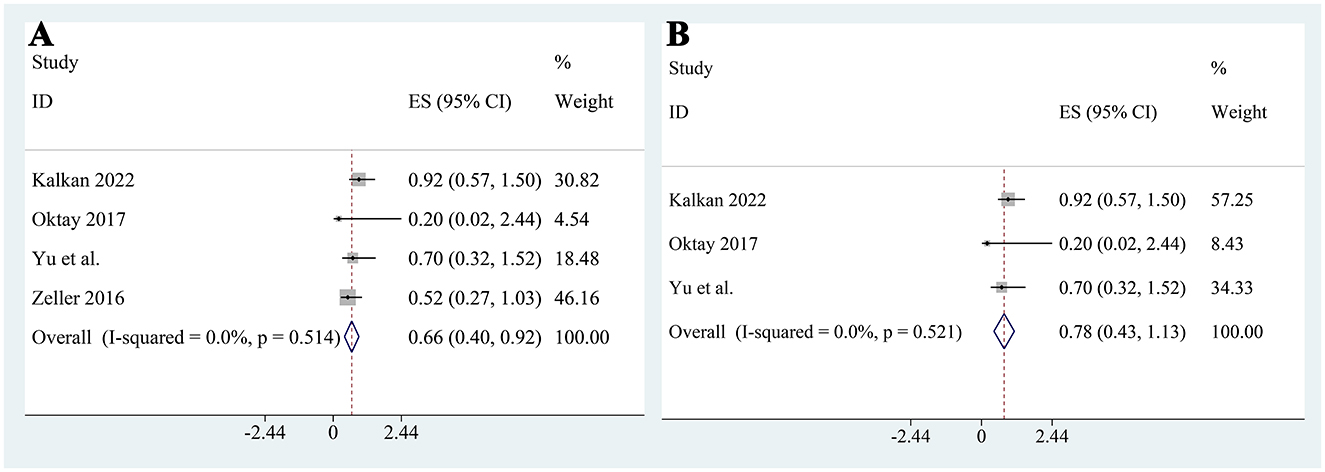
Figure 7. Pooled logistic regression analysis of the association between metformin use and CI-AKI. (A) Combined adjusted OR from all included studies; (B) Sensitivity analysis excluding Zeller et al.
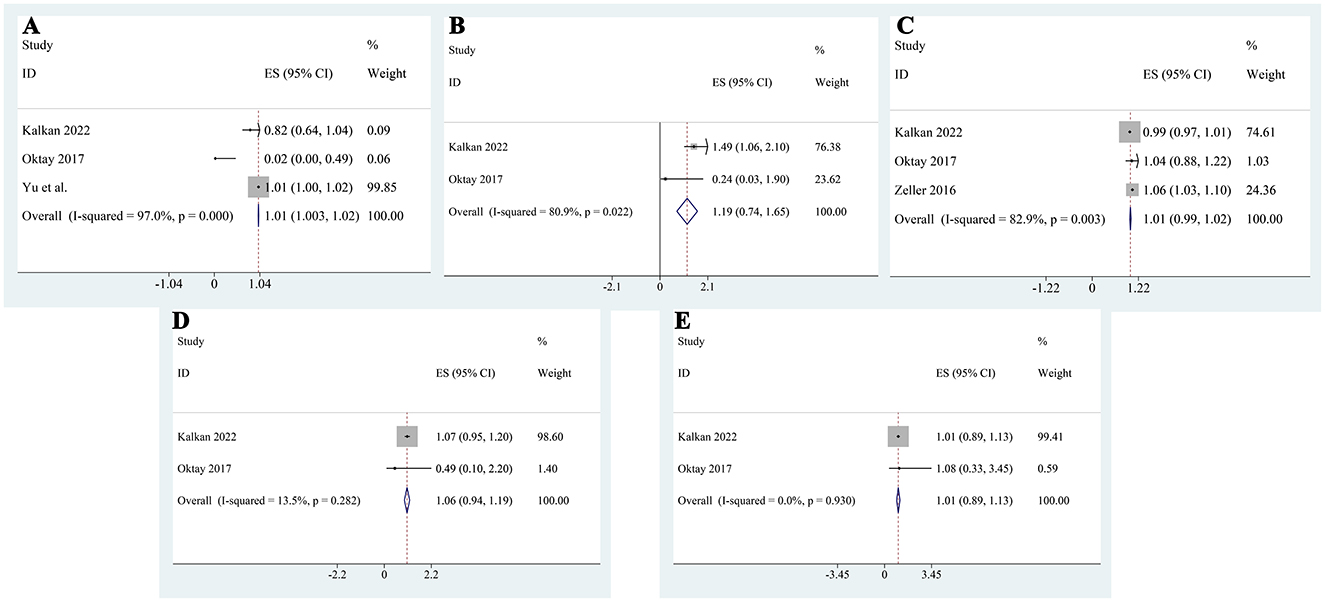
Figure 8. Pooled logistic regression results for additional covariates potentially associated with CI-AKI: (A) contrast volume; (B) baseline serum creatinine; (C) age; (D) glycated hemoglobin; (E) hemoglobin level.
Meta-analysis of logistic regression of metabolic acidosis
Our pooled analysis showed that neither age (Figure 9A) nor continuation of metformin (Figure 9B) use was significantly associated with the occurrence of metabolic acidosis. In contrast, baseline CO2 levels demonstrated a significant inverse association with metabolic acidosis risk. Specifically, the pooled logistic regression analysis indicated that lower CO2 levels were independently associated with a higher risk of metabolic acidosis (OR: 0.71, 95% CI: 0.65–0.76; Figure 9C), highlighting CO2 as a potential protective factor.

Figure 9. Pooled logistic regression results for predictors of metabolic acidosis: (A) age; (B) metformin use; (C) baseline CO2 level.
Publication bias
With fewer than 10 trials, publication bias was not assessed using funnel plots.
Discussion
The study found no significant differences in the occurrence of CI-AKI, lactate levels, incidence of acidosis, and alterations in renal function parameters between diabetic patients who are using metformin and those who are not. However, sensitivity analysis showed that after excluding the study by Yu et al., which introduced methodological heterogeneity, the pooled results indicated a statistically significant reduction in serum creatinine levels among patients who continued metformin. In addition, meta-analysis of logistic regression results revealed that metformin use was not independently associated with an increased risk of CI-AKI. The pooled adjusted OR suggested a potential protective effect, though this association became no significant after excluding the study by Zeller et al. (25), which did not adjust for baseline eGFR as a continuous variable. Among other covariates, contrast volume consistently emerged as a statistically significant independent risk factor for CI-AKI, while age, baseline creatinine, HbA1c, and hemoglobin were not associated. For metabolic acidosis, logistic regression meta-analysis demonstrated that neither age nor metformin continuation was associated with increased risk. In contrast, lower baseline CO2 levels were significantly associated with a higher risk of metabolic acidosis, highlighting CO2 as a potential independent predictor. Previous meta-analyses have also examined the relationship between metformin use and the occurrence of CI-AKI in patients undergoing iodine contrast agent examinations (26–28). Their conclusions indicated that continued use of metformin was not associated with CI-AKI. However, these studies primarily focused on patients taking metformin, whereas our meta-analysis specifically compared diabetic patients taking metformin with those who were not. Metformin is best known for its role in lowering blood glucose levels in diabetic patients (29). As research advances, investigators have discovered significant therapeutic effects of metformin in reducing cardiovascular events and combating obesity, among other benefits (30–32). Furthermore, there is increasing evidence suggesting potential benefits of metformin in conditions such as cancer, neurodegenerative diseases, metabolic syndrome, polycystic ovary syndrome, aging, and COVID-19 (33–39).
Diabetic patients have a higher susceptibility to developing lactic acidosis and renal function impairment compared to non-diabetic individuals (40). Poor glycemic control and abnormal energy metabolism contribute to increased lactate production, while impaired kidney function reduces lactate clearance. Additionally, diabetic patients may experience both ketoacidosis and lactic acidosis simultaneously, leading to more severe accumulation of acidic substances in the body (41). However, the population solely taking metformin includes non-diabetic individuals as well. Therefore, when Qiao et al. combined data from diabetic and non-diabetic patients for analysis, the study exhibited considerable heterogeneity, which undermined the credibility of its conclusions (28).
The belief that metformin should be discontinued in patients undergoing contrast agent treatment arises from the association of metformin with lactic acidosis and CI-AKI. This perspective stems from phenformin, a drug related to metformin, which was found to increase hepatic lactate production, leading to lactic acidosis and subsequently withdrawn from the market starting in 1978. Despite the similarity in their names, the chemical structure of metformin is significantly different. Metformin can inhibit hepatic gluconeogenesis without altering lactate turnover (42). A community-based cohort study involving around 1 million diabetic patients in the United States also indicates that metformin use is associated with acidosis only when the eGFR is below 30 mL/min/1.73 m2 (27, 43). Furthermore, emerging evidence indicates that in diabetic patients receiving metformin treatment, the majority of cases of lactic acidosis cannot be attributed to metformin toxicity (12, 13). Lactic acidosis can occur in non-diabetic patients in various conditions such as sepsis, hepatic failure, and renal failure. In fact, almost all reported cases of metformin-associated lactic acidosis occur in patients with comorbidities. Our study's results also confirm that metformin is not associated with the occurrence of lactic acidosis. The Korean Diabetes Association have reached a consensus on the use of metformin in type 2 diabetes complicated by renal insufficiency, particularly when these patients undergo imaging studies with CM. Renal function should be assessed before any CM-related procedure (44). Metformin is safe with eGFR ≥45; use ≤ 1,000 mg daily if eGFR is 30–44. It is contraindicated if eGFR <30 mL/min/1.73 m2. As the included studies did not specifically specify populations based on glomerular filtration rate, with Oktay et al. and Zeller et al. analyzing populations with eGFR <60 mL/min/1.73 m2 (23, 25), there were no reports on populations with glomerular filtration rates <30 mL/min/1.73 m2, so subgroup analysis based on different eGFR levels could not be performed.
Limitations
This study has several limitations. First, apart from the 2 RCT studies, the remaining 5 studies were retrospective cohort studies. While their NOS scores were all >6 points, retrospective cohort studies are subject to risks of information bias and recall bias compared to RCT. Due to the inability to control confounding factors, their internal validity is lower, which may lead to biased results. Second, the included populations exhibited significant heterogeneity. In studies by Kalkan et al. (20) and Kim et al. (21), the creatinine levels in the non-metformin group were higher than those in the metformin group, reducing the accuracy and credibility of the combined effects. Third, since most diabetic patients often have multiple comorbidities, including hypertension, and may require antihypertensive medications, these drugs may also influence the study results (20). Forth, different trails may have treated the control group differently. Some studies suspended metformin intake before imaging, while in other studies, the control group took other antidiabetic medications. Fifth, subgroup analyses based on baseline eGFR and metformin dosage were not feasible due to inconsistent and incomplete reporting across studies. We acknowledge the value of such stratification and recommend future studies provide standardized data to enhance clinical applicability.
Conclusion
No evidence suggests that continuing metformin during contrast medium administration increases the risk of CI-AKI, lactic acidosis, or worsening eGFR compared to those who discontinue or do not use metformin. In contrast, continuation of metformin may be associated with a modest reduction in serum creatinine following contrast exposure. For patients with eGFR <30 mL/min/1.73 m2, safety data is insufficient, requiring further research. More large-scale RCTs are needed to confirm these findings.
Data availability statement
The raw data supporting the conclusions of this article will be made available by the authors, without undue reservation.
Author contributions
QX: Conceptualization, Formal analysis, Funding acquisition, Investigation, Methodology, Project administration, Resources, Software, Supervision, Validation, Visualization, Writing – original draft, Writing – review & editing. WH: Data curation, Investigation, Methodology, Validation, Writing – original draft. QL: Investigation, Methodology, Project administration, Validation, Writing – original draft. TB: Data curation, Methodology, Writing – original draft. HL: Data curation, Project administration, Supervision, Validation, Writing – original draft, Writing – review & editing. XL: Conceptualization, Data curation, Formal analysis, Funding acquisition, Investigation, Methodology, Project administration, Resources, Software, Supervision, Validation, Visualization, Writing – original draft, Writing – review & editing.
Funding
The author(s) declare that no financial support was received for the research and/or publication of this article.
Conflict of interest
The authors declare that the research was conducted in the absence of any commercial or financial relationships that could be construed as a potential conflict of interest.
Generative AI statement
The author(s) declare that no Gen AI was used in the creation of this manuscript.
Publisher's note
All claims expressed in this article are solely those of the authors and do not necessarily represent those of their affiliated organizations, or those of the publisher, the editors and the reviewers. Any product that may be evaluated in this article, or claim that may be made by its manufacturer, is not guaranteed or endorsed by the publisher.
References
1. International Diabetes Federation (IDF) (2025). IDF Diabetes Atlas tEB. Belgium: International Diabetes Federation. Available online at: https://diabetesatlas.org/media/uploads/sites/3/2025/04/IDF_Atlas_11th_Edition_2025.pdf (accessed May 10, 2025).
2. Feng XS, Farej R, Dean BB, Xia F, Gaiser A, Kong SX, et al. CKD prevalence among patients with and without type 2 diabetes: regional differences in the United States. Kidney Med. (2022) 4:100385. doi: 10.1016/j.xkme.2021.09.003
3. Hoogeveen EK. The epidemiology of diabetic kidney disease. Kidney Dial. (2022) 2:433–42. doi: 10.3390/kidneydial2030038
4. Kajbaf F, Lalau JD. The prognostic value of blood pH and lactate and metformin concentrations in severe metformin-associated lactic acidosis. BMC Pharmacol Toxicol. (2013) 14:22. doi: 10.1186/2050-6511-14-22
5. Piel S, Ehinger JK, Elmér E, Hansson MJ. Metformin induces lactate production in peripheral blood mononuclear cells and platelets through specific mitochondrial complex I inhibition. Acta Physiol. (2015) 213:171–80. doi: 10.1111/apha.12311
6. Agius L, Ford BE, Chachra SS. The metformin mechanism on gluconeogenesis and AMPK activation: the metabolite perspective. Int J Mol Sci. (2020) 21:240. doi: 10.3390/ijms21093240
7. See KC. Metformin-associated lactic acidosis: a mini review of pathophysiology, diagnosis and management in critically ill patients. World J Diabetes. (2024) 15:1178–86. doi: 10.4239/wjd.v15.i6.1178
8. Khatami MR, Nikravan N, Salari-Far M, Davoudi S, Pahlavan-Sabbagh MR. A comparison of definitions of contrast-induced nephropathy in patients with normal serum creatinine. Saudi J Kidney Dis Transpl. (2016) 27:94–100. doi: 10.4103/1319-2442.174086
9. van der Molen AJ, Reimer P, Dekkers IA, Bongartz G, Bellin MF, Bertolotto M, et al. Post-contrast acute kidney injury Part 2: risk stratification, role of hydration and other prophylactic measures, patients taking metformin and chronic dialysis patients: recommendations for updated ESUR Contrast Medium Safety Committee guidelines. Eur Radiol. (2018) 28:2856–69. doi: 10.1007/s00330-017-5247-4
10. van der Molen AJ, Reimer P, Dekkers IA, Bongartz G, Bellin MF, Bertolotto M, et al. Post-contrast acute kidney injury—part 1: definition, clinical features, incidence, role of contrast medium and risk factors: recommendations for updated ESUR Contrast Medium Safety Committee guidelines. Eur Radiol. (2018) 28:2845–55. doi: 10.1007/s00330-017-5246-5
11. Lalau JD, Race JM. Lactic acidosis in metformin-treated patients prognostic value of arterial lactate levels and plasma metformin concentrations. Drug Saf. (1999) 20:377–84. doi: 10.2165/00002018-199920040-00006
12. Lalau JD, Kajbaf F, Protti A, Christensen MM, De Broe ME, Wiernsperger N. Metformin-associated lactic acidosis (MALA): Moving towards a new paradigm. Diabetes Obes Metab. (2017) 19:1502–12. doi: 10.1111/dom.12974
13. Lazzeri C, Valente S, Chiostri M, Attanà P, Picariello C, Gensini GF. The prognostic role of in-hospital peak glycemia in stemi patients with and without diabetes. Acta Diabetol. (2012) 49:379–86. doi: 10.1007/s00592-011-0343-4
14. Berlyand Y, Fraga JA, Succi MD, Yun BJ, Lee AH, Baugh JJ, et al. Impact of iodinated contrast allergies on emergency department operations. Am J Emerg Med. (2022) 61:127–30. doi: 10.1016/j.ajem.2022.08.052
15. Cumpston M, Li T, Page MJ, Chandler J, Welch VA, Higgins JP, et al. Updated guidance for trusted systematic reviews: a new edition of the Cochrane Handbook for Systematic Reviews of Interventions. Cochrane Database Syst Rev. (2019) 10:Ed000142. doi: 10.1002/14651858.ED000142
16. Liberati A, Altman DG, Tetzlaff J, Mulrow C, Gøtzsche PC, Ioannidis JP, et al. The PRISMA statement for reporting systematic reviews and meta-analyses of studies that evaluate health care interventions: explanation and elaboration. PLoS Med. (2009) 6:e1000100. doi: 10.1371/journal.pmed.1000100
17. Higgins JP, Altman DG, Gøtzsche PC, Jüni P, Moher D, Oxman AD, et al. The Cochrane Collaboration's tool for assessing risk of bias in randomised trials. BMJ. (2011) 343:d5928. doi: 10.1136/bmj.d5928
18. Wells G, Shea B, O'Connell J. The newcastle-ottawa scale (NOS) for assessing the quality of nonrandomised studies in meta-analyses. Ottawa Health Res. Inst. (2014) 7.
19. Jung J, Cho YY, Jung JH, Kim KY, Kim HS, Baek JH, et al. Are patients with mild to moderate renal impairment on metformin or other oral anti-hyperglycaemic agents at increased risk of contrast-induced nephropathy and metabolic acidosis after radiocontrast exposure? Clin Radiol. (2019) 74:651.e1–651.e6. doi: 10.1016/j.crad.2019.05.011
20. Kalkan S, Karagöz A, Efe S, Sungur MA, Simşek B, Yilmaz MF, et al. Metformin and CI-AKI risk in STEMI: evaluation using propensity score weighting method. Turk Kardiyol Dern Ars. (2022) 50:422–30. doi: 10.5543/tkda.2022.22430
21. Kim SK, Jung J, Jung JH, Kim KY, Baek JH, Hahm JR. The association between use of metformin and change in serum CO2 level after administration of contrast medium. Clin Radiol. (2016) 71:532–6. doi: 10.1016/j.crad.2016.02.007
22. Namazi MH, AlipourParsa S, Roohigilani K, Safi M, Vakili H, Khaheshi I, et al. Is it necessary to discontinue metformin in diabetic patients with GFR > 60 ml/min per 1.73 m2 undergoing coronary angiography: a controversy still exists? Acta Biomed. (2018) 89:227–32. doi: 10.23750/abm.v89i2.5446
23. Oktay V, Calpar Çirali I, Sinan Ü, Yildiz A, Ersanli MK. Impact of continuation of metformin prior to elective coronary angiography on acute contrast nephropathy in patients with normal or mildly impaired renal functions [Journal article]. Anatol. J. Cardiol. (2017) 18:334–39. doi: 10.14744/AnatolJCardiol.2017.7836
24. Yu Q, Zhu J-J, Liu W-X. Effect of continuous use of metformin on kidney function in diabetes patients with acute myocardial infarction undergoing primary percutaneous coronary intervention. BMC Cardiovasc Disord. (2020) 20:187. doi: 10.1186/s12872-020-01474-5
25. Zeller M, Labalette-Bart M, Juliard JM, Potier L, Feldman LJ, Steg PG, et al. Metformin and contrast-induced acute kidney injury in diabetic patients treated with primary percutaneous coronary intervention for ST segment elevation myocardial infarction: amulticenter study. Int J Cardiol. (2016) 220:137–42. doi: 10.1016/j.ijcard.2016.06.076
26. Goergen SK, Rumbold G, Compton G, Harris C. Systematic review of current guidelines, and their evidence base, on risk of lactic acidosis after administration of contrast medium for patients receiving metformin. Radiology. (2010) 254:261–9. doi: 10.1148/radiol.09090690
27. Kao TW, Lee KH, Chan WP, Fan KC, Liu CW, Huang YC. Continuous use of metformin in patients receiving contrast medium: what is the evidence? A systematic review and meta-analysis. Eur Radiol. (2022) 32:3045–55. doi: 10.1007/s00330-021-08395-7
28. Qiao H, Li Y, Xu B, Lu Z, Zhang J, Meng D, et al. Metformin can be safely used in patients exposed to contrast media: a systematic review and meta-analysis. Cardiology. (2022) 147:469–78. doi: 10.1159/000527384
29. Du Y, Zhu YJ, Zhou YX, Ding J, Liu JY. Metformin in therapeutic applications in human diseases: its mechanism of action and clinical study. Mol Biomed. (2022) 3:41. doi: 10.1186/s43556-022-00108-w
30. Ren Y, Luo H. Metformin: the next angiogenesis panacea? SAGE Open Med. (2021) 9:20503121211001641. doi: 10.1177/20503121211001641
31. Han Y, Xie H, Liu Y, Gao P, Yang X, Shen Z. Effect of metformin on all-cause and cardiovascular mortality in patients with coronary artery diseases: a systematic review and an updated meta-analysis. Cardiovasc Diabetol. (2019) 18:96. doi: 10.1186/s12933-019-0900-7
32. Lamanna C, Monami M, Marchionni N, Mannucci E. Effect of metformin on cardiovascular events and mortality: a meta-analysis of randomized clinical trials. Diabetes Obes Metab. (2011) 13:221–8. doi: 10.1111/j.1463-1326.2010.01349.x
33. Chen YC, Li H, Wang J. Mechanisms of metformin inhibiting cancer invasion and migration. Am J Transl Res. (2020) 12:4885–901.
34. Ma R, Yi B, Riker AI, Xi Y. Metformin and cancer immunity. Acta Pharmacol Sin. (2020) 41:1403–9. doi: 10.1038/s41401-020-00508-0
35. Ping F, Jiang N, Li Y. Association between metformin and neurodegenerative diseases of observational studies: systematic review and meta-analysis. BMJ Open Diabetes Res Care. (2020) 8:1370. doi: 10.1136/bmjdrc-2020-001370
36. Negrotto L, Farez MF, Correale J. Immunologic effects of metformin and pioglitazone treatment on metabolic syndrome and multiple sclerosis. JAMA Neurol. (2016) 73:520–8. doi: 10.1001/jamaneurol.2015.4807
37. Facchinetti F, Orrù B, Grandi G, Unfer V. Short-term effects of metformin and myo-inositol in women with polycystic ovarian syndrome (PCOS): a meta-analysis of randomized clinical trials. Gynecol Endocrinol. (2019) 35:198–206. doi: 10.1080/09513590.2018.1540578
38. Bharath LP, Agrawal M, McCambridge G, Nicholas DA, Hasturk H, Liu J, et al. Metformin enhances autophagy and normalizes mitochondrial function to alleviate aging-associated inflammation. Cell Metab. (2020) 32:44–55.e6. doi: 10.1016/j.cmet.2020.04.015
39. Scheen AJ. Metformin and COVID-19: from cellular mechanisms to reduced mortality. Diabetes Metab. (2020) 46:423–6. doi: 10.1016/j.diabet.2020.07.006
40. Weisberg LS. Lactic acidosis in a patient with type 2 diabetes mellitus. Clin J Am Soc Nephrol. (2015) 10:1476–83. doi: 10.2215/CJN.10871014
41. Bhat JA, Masoodi SR, Bhat MH, Bhat H, Ahmad PO, Sood M. Lactic acidosis in diabetic ketoacidosis: a marker of severity or alternate substrate for metabolism. Indian J Endocrinol Metab. (2021) 25:59–66. doi: 10.4103/ijem.IJEM_753_20
42. Salpeter SR, Greyber E, Pasternak GA, Salpeter EE. Risk of fatal and nonfatal lactic acidosis with metformin use in type 2 diabetes mellitus. Cochrane Database Syst Rev. (2010) 2010:Cd002967. doi: 10.1002/14651858.CD002967.pub4
43. Posma RA, Lexis CP, Lipsic E, Nijsten MW, Damman K, Touw DJ, et al. Effect of metformin on renal function after primary percutaneous coronary intervention in patients without diabetes presenting with ST-elevation myocardial infarction: data from the GIPS-III trial. Cardiovasc Drugs Ther. (2015) 29:451–9. doi: 10.1007/s10557-015-6618-1
Keywords: contrast agent, diabetic, renal function, CI-AKI, lactate
Citation: Xu Q, Huang W, Li Q, Bao T, Luo H and Luo X (2025) Systematic review and meta-analysis of current guidelines, and their evidence base, on risk of renal function after administration of contrast medium for diabetic patients receiving metformin. Front. Med. 12:1547725. doi: 10.3389/fmed.2025.1547725
Received: 18 December 2024; Accepted: 09 June 2025;
Published: 26 June 2025.
Edited by:
Agnieszka Śliwińska, Medical University of Lodz, PolandReviewed by:
Makoto Katoh, Saitama Medical University, JapanMarcin Kosmalski, Medical University of Lodz, Poland
Copyright © 2025 Xu, Huang, Li, Bao, Luo and Luo. This is an open-access article distributed under the terms of the Creative Commons Attribution License (CC BY). The use, distribution or reproduction in other forums is permitted, provided the original author(s) and the copyright owner(s) are credited and that the original publication in this journal is cited, in accordance with accepted academic practice. No use, distribution or reproduction is permitted which does not comply with these terms.
*Correspondence: Hua Luo, bHVvaDUzNjdAZW56ZW1lZC5jb20=; Xiao Luo, bHVveGlhb0BlbnplbWVkLmNvbQ==
†These authors have contributed equally to this work
 Qinhui Xu
Qinhui Xu Weixing Huang2,3†
Weixing Huang2,3† Hua Luo
Hua Luo Xiao Luo
Xiao Luo